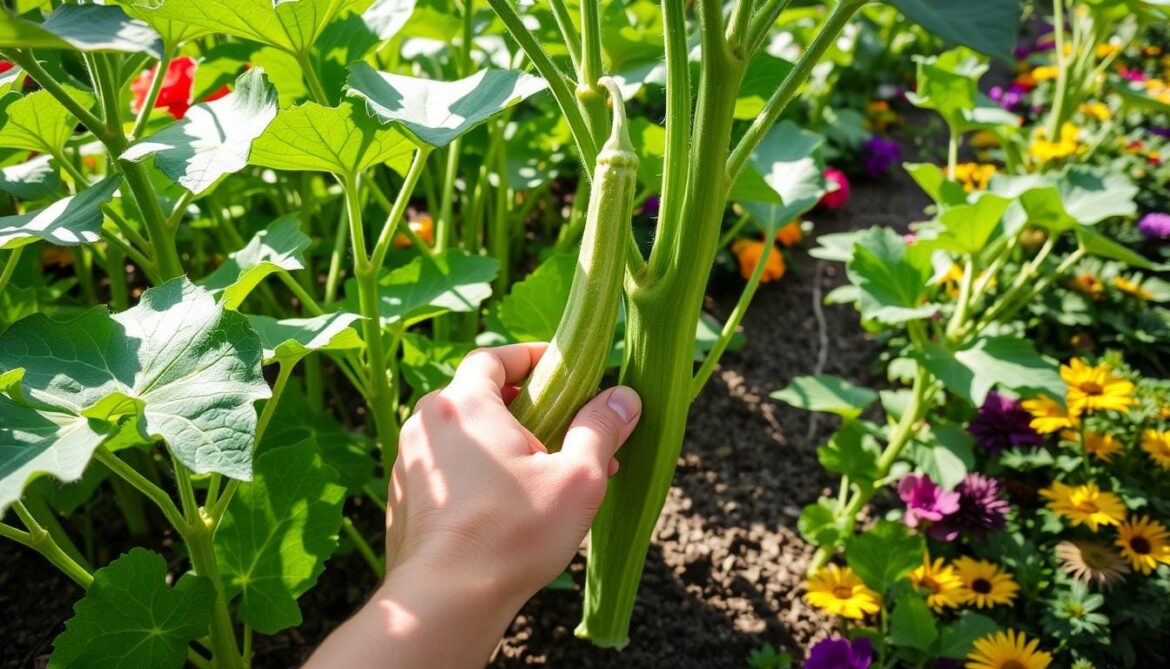Growing okra in our backyard garden has been a journey of discovery. It’s filled with moments of excitement and learning. The first time I saw those delicate green pods emerge, I knew harvesting okra was more than just a task. It’s an art that can make your cooking extraordinary.
Knowing when to harvest okra is key for its best flavor and texture. Harvesting at the right time means tender, delicious pods for cooking. Most okra varieties are ready to harvest about 60 to 70 days after planting. They should be 2 to 3 inches long.
This guide will help you understand when to harvest okra. You’ll learn how to grow okra successfully. We’ll share expert tips on recognizing the perfect picking moment.
Key Takeaways
- Harvest okra pods when they reach 2-3 inches in length
- Pick okra every 2-3 days during growing season
- Pods mature approximately 60-70 days after planting
- Regular harvesting encourages continuous pod production
- Fresh okra should be consumed quickly for best flavor
Understanding Okra Growth Stages
Growing okra is a journey through different stages. Our guide will show you how okra grows from seed to harvest. Knowing these stages helps you get the most from your crop.
Germination and Seedling Development
The okra journey starts with planting seeds. Plant them 0.5 to 1 inch deep in warm soil, 10-12 inches apart. Seeds need consistent moisture and 70-85°F temperatures to germinate well.
- Seed depth: 0.5-1 inch
- Optimal soil temperature: 70-85°F
- Recommended plant spacing: 10-12 inches
Vegetative Growth Phase
Okra plants grow into tall structures. They can reach 3-7 feet tall, with leaves up to 8-12 inches wide. This phase is about building strong roots and foliage.
| Growth Characteristic | Typical Measurement |
|---|---|
| Plant Height | 3-7 feet |
| Leaf Diameter | 8-12 inches |
| Row Spacing | 3-6 feet |
Flowering and Pod Formation
About 50-65 days after planting, okra starts its exciting phase. Hibiscus-like flowers appear, marking the start of pod production. Pods grow quickly, forming in just 1-2 days after flowers.
Peak productivity happens when plants produce blossoms and pods daily.
For the best okra, harvest pods when they’re 2-3 inches long. Larger pods are less tasty. Harvesting every 2-3 days helps keep production high, potentially getting over 30 pods per plant.
Indicators for Harvest Time
Knowing when to pick okra pods is key. Our gardening experts have a guide to help you know when to harvest. This way, you’ll get the best from your okra crop.
Color Change in Okra Pods
The color of okra pods tells you if they’re ready. Fresh pods are bright green or deep purple, depending on the type. Pale or yellowing pods mean they’re too old. Look for pods with a rich color for the best taste.
Size of the Pods
The size of okra pods is important too. Pods should be 2 to 3 inches long. Longer pods are:
- Woody in texture
- Tough to chew
- Less flavorful
Texture of the Pods
Texture also shows if okra is ready. Check the pods by feeling them:
- Perfectly ripe pods are firm but not hard
- Soft or mushy pods are overripe
- Pods should snap when bent
“The secret to delicious okra is catching it at just the right moment – not too young, not too old.” – Southern Gardening Expert
By watching color, size, and texture, you’ll learn to harvest okra perfectly. Harvesting often, like every two days, helps you catch them at their best.
Timing for Optimal Harvesting
Understanding when to harvest okra is key to a successful crop. Knowing the best time and frequency helps you get tender, tasty pods all season long.
Best Time of Day to Harvest
The best time to pick okra is early morning or late evening. These cooler times help the plants stay healthy and the pods stay crisp. Picking in the hottest part of the day can make pods wilt and lose flavor.
- Morning harvest: 6-8 AM (recommended)
- Evening harvest: 6-8 PM
- Avoid midday harvesting when temperatures are highest
Frequency of Harvesting
Harvesting okra often is important for a good crop. Okra pods grow fast, often in just one day. Our suggested schedule helps keep the pods coming.
| Plant Age | Harvesting Frequency | Pod Size |
|---|---|---|
| Early Stage (60-70 days) | Every 2-3 days | 2-3 inches long |
| Peak Production | Every 1-2 days | 3-4 inches long |
“Consistent harvesting is the key to a bountiful okra crop.” – Gardening Expert
By sticking to these tips, we can get the most from our okra. This way, we enjoy fresh, tender pods all summer. And remember, the more you pick, the more the plant will grow!
Seasonal Considerations for Harvesting
Knowing when to harvest okra depends on the local weather in the United States. Okra loves warm weather, making it a top pick for summer gardens.
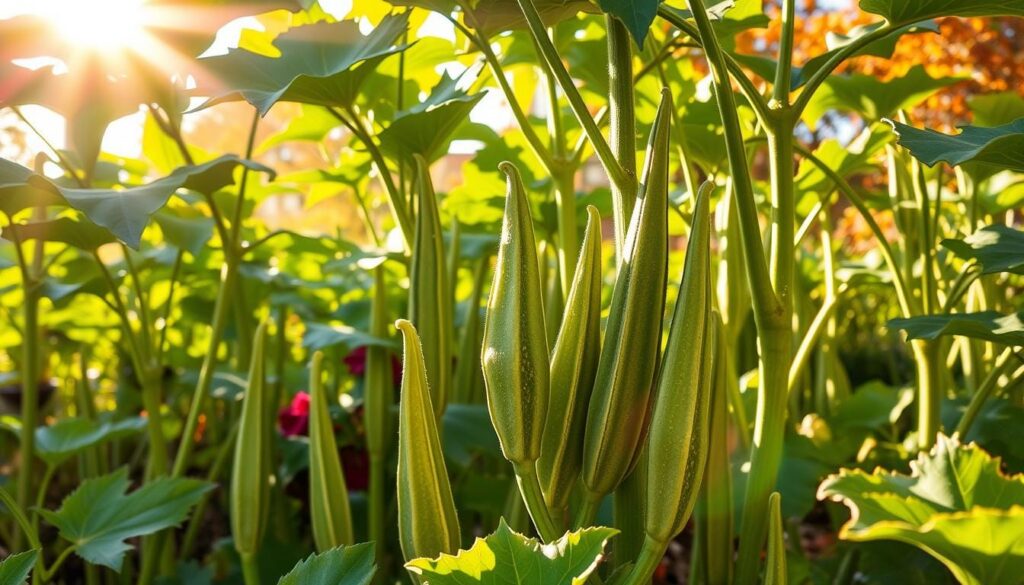
Success in growing okra comes down to several weather factors. Each area has its own best times for planting and picking.
Growing Season Variations Across the United States
Our study shows important facts about okra’s growing season:
- Southern states have longer okra seasons
- Northern areas have shorter, focused growing times
- Soil must be at least 62°F for okra to grow well
Climate Impact on Harvest Timing
The okra season usually runs from late spring to early fall. Important weather factors include:
- Warm soil is key for germination
- Temperature affects pod growth
- Enough daylight boosts plant output
*”Okra is a heat-loving crop that demands strategic planting and careful monitoring,”* says Dr. Emily Rodriguez, an agricultural expert.
To get the most from your okra, watch the local weather and pick the right varieties for your area. Farmers can expect 60-70 days from planting to harvest. With the right planning, you can have two harvests a year.
By planning carefully, you can turn your garden into a thriving summer vegetable spot.
Tools We Need for Harvesting Okra
Getting ready to harvest okra means you need the right tools and safety gear. You want to harvest okra well and stay safe from the plant’s spines.
Essential Equipment for Harvesting
To harvest okra, you’ll need specific tools. These tools make harvesting easier and more comfortable. Here’s what we suggest:
- Hand pruners or sharp garden scissors
- The Handy Twine Knife (available in 5 colors and sizes)
- Harvesting basket or lightweight container
- Over-the-shoulder harvesting bucket
“The right tool can make harvesting okra both enjoyable and productive.”
Safety Gear Recommendations
Okra plants have tiny spines that can hurt your skin. So, wearing protective gear is key. Here’s what we recommend:
- Long-sleeved shirts
- High-quality garden gloves
- Lightweight, breathable pants
- Comfortable closed-toe shoes
| Tool | Purpose | Recommended Features |
|---|---|---|
| Garden Gloves | Skin Protection | Thick, puncture-resistant material |
| Pruning Shears | Pod Cutting | Sharp, ergonomic design |
| Harvesting Basket | Collecting Pods | Lightweight, breathable |
Pro tip: Invest in quality tools that can last up to 10 years with proper maintenance. About 75% of gardeners find that using specialized tools significantly enhances harvesting efficiency.
Techniques for Harvesting Okra
Picking okra pods needs careful technique to keep plants healthy and get the most yield. Our guide will show you the best ways to harvest this tasty vegetable.
There are two main ways to pick okra pods: by hand or with cutting tools. Each method has its own benefits and things to consider for keeping plants productive.
Hand Harvesting Methods
Hand harvesting is simple but needs precision. Here are some important techniques:
- Wear protective gloves to avoid irritation from okra’s tiny spines
- Grasp the pod gently but firmly near its base
- Use a quick snapping motion to remove the pod
- Harvest when pods are 2-3 inches long for the best tenderness
Using Cutting Tools
For more delicate harvesting, cutting tools have several advantages:
- Use sharp garden shears or a clean knife
- Cut pods with a short 1/4 inch stem attached
- Minimize plant damage during picking okra pods
- Reduce stress on the plant’s structure
“The key to successful okra harvesting is gentleness and frequency.”
Pro tip: Harvest every 2-3 days to keep pods coming. Okra plants usually produce for 60-70 days after planting. Regular picking keeps your plants healthy and productive.
Post-Harvest Care for Okra
After harvesting your okra, it’s important to take good care of it. This helps keep it fresh and tasty. Knowing how to handle your okra right can keep its flavor and nutrients.
Cleaning the Pods
Cleaning okra pods needs to be done carefully. Here’s how to do it right:
- Rinse pods quickly under cool water
- Avoid soaking, which can introduce excess moisture
- Pat dry with a clean kitchen towel
- Remove any visible dirt or debris
Storing Okra for Maximum Freshness
Storing okra properly is key to keeping it fresh. Our tips will help you keep your okra pods tasty and fresh.
| Storage Method | Temperature | Expected Freshness |
|---|---|---|
| Refrigerator Storage | 45-50°F | Up to 7 days |
| Perforated Plastic Bag | 45-50°F | 5-7 days |
Pro tip: Always store okra in the warmest part of your refrigerator to prevent cold damage.
“Treat your okra gently, and it will reward you with peak flavor and texture.” – Garden Harvest Experts
By taking good care of your okra after harvesting, it will stay fresh and delicious. Remember, the way you handle your okra after picking is just as important as growing it.
Common Mistakes to Avoid When Harvesting Okra
Harvesting okra needs precision and care. Gardeners often make mistakes that hurt their crop’s yield and quality. Knowing these mistakes can help you get the most from your okra.
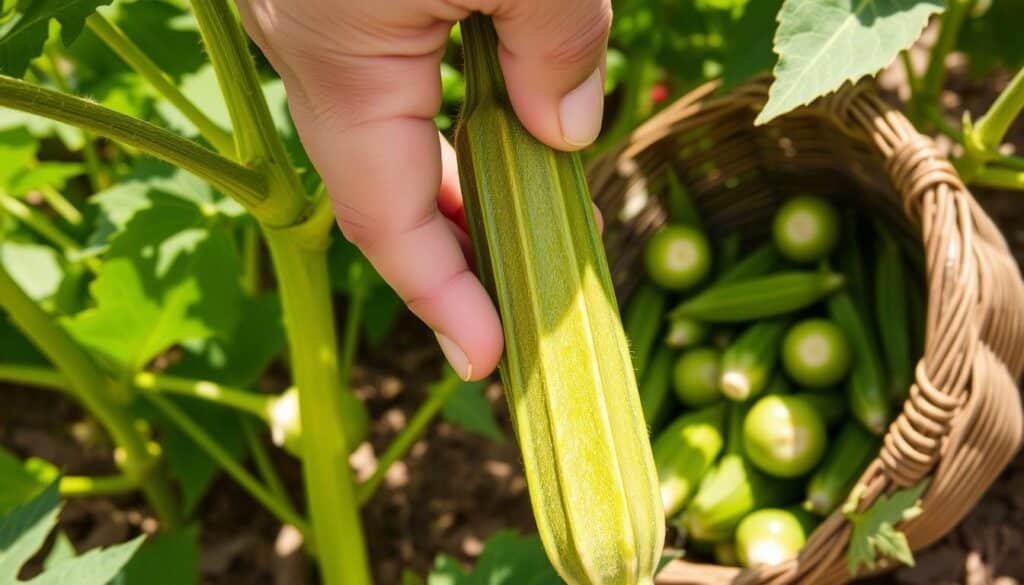
Both new and experienced gardeners face challenges when picking okra. These pods are delicate and need careful handling during harvest.
Waiting Too Long to Harvest
Waiting too long to pick okra can harm your garden. Here’s what happens:
- Pod production slows down
- Existing pods become tough and woody
- Plant productivity drops
“Timing is everything when harvest okra. Delay means lost opportunity.” – Gardening Expert
Improper Handling of Okra Pods
Okra pods are very delicate and need gentle care. Rough handling can cause bruising, damage, and lower quality. Here’s how to handle them right:
- Use sharp, clean scissors for cutting
- Wear protective gloves to avoid skin irritation
- Handle pods with care to keep them intact
Most okra varieties do best when picked at 2 to 4 inches long. Pods longer than that become tough and less tasty. By knowing this, we can ensure a rich and tasty okra harvest.
The Role of Pollination
Pollination is key for okra plant success, affecting pod formation and harvest. Knowing how pollination works can boost your okra crop.
Okra flowers can pollinate themselves. They don’t need outside help to make pods. Interestingly, okra flowers open at sunrise and close by noon, creating a narrow window for effective fertilization.
How Pollination Impacts Harvest Timing
Pollination affects okra plant success. Several factors are important for pod growth:
- Anthers release pollen shortly after blooming
- Honeybees and bumble bees frequently visit okra flowers
- Environmental conditions significantly impact pollen viability
Signs of Successful Pollination
Spotting successful pollination needs close watching. Look for these signs:
- Wilting flower petals after blooming
- Initial small pod formation at the flower’s base
- Consistent pod development within 4-6 days
“The dance of pollination determines the rhythm of our okra harvest.” – Agricultural Wisdom
Keep an eye on the environment for better okra growth. High heat can make pollen sticky, while low humidity can make it sterile. This might lower pod formation.
Nutritional Benefits of Fresh Okra
Harvesting okra at the right time ensures peak flavor and maximizes its nutritional benefits. Our fresh okra is a health powerhouse, bringing amazing benefits from the garden to your plate.
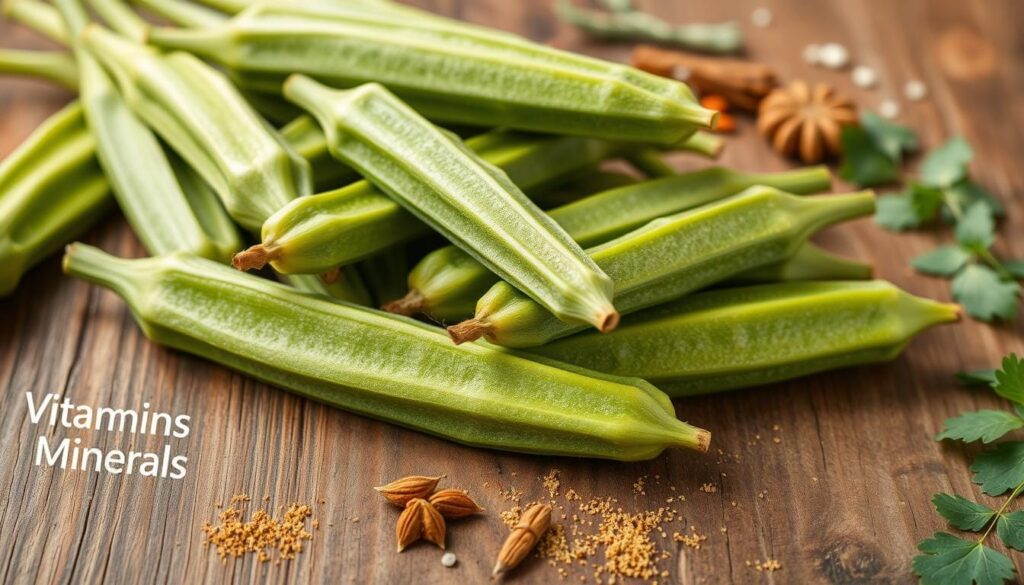
Okra is a nutritional gem, packed with essential vitamins and minerals. One cup of raw okra offers a wealth of nutrients that support overall health:
- Only 33 calories per 100 grams
- Rich in dietary fiber (3.2 g)
- Excellent source of vitamin K and potassium
- Contains important minerals like magnesium and calcium
Vitamins and Minerals in Okra
During okra harvesting time, you’ll want to capture these key nutritional highlights:
| Nutrient | Amount per 100g | Daily Value % |
|---|---|---|
| Vitamin C | 23 mg | 38% |
| Magnesium | 57 mg | 14% |
| Potassium | 299 mg | 9% |
Culinary Uses for Harvested Okra
Freshly harvested okra offers versatile culinary options. Southern kitchens love breading and deep-frying these pods. Creative cooks pickle them to extend their harvest. Pro tip: The younger pods contain maximum nutrient concentration, so harvest frequently!
“Okra is not just a vegetable, it’s a nutritional powerhouse waiting to be explored!” – Nutritional Expert
Our research reveals fascinating health benefits. A 2014 study showed okra’s lectin could reduce breast cancer cell growth by 63% in laboratory tests. Its high fiber content also supports heart health and digestive wellness.
How Weather Affects Okra Harvesting
Weather is very important for okra plants. It affects how they grow, develop pods, and stay healthy. Knowing how weather impacts okra helps gardeners and farmers get the best harvest.
Okra loves warm weather and lots of sunlight. It grows best in USDA Zones 5-11. The soil needs to be at least 60°F for seeds to germinate. The best growth happens when it’s between 65-75°F.
Dealing with Heat Waves
Okra plants are very strong during heat waves. Gardeners should be ready to change how they harvest when it gets too hot.
- Water plants every day
- Pick okra early in the morning
- Keep an eye on how wet the plants are
Managing Rainy Conditions
Too much water can be a problem for okra. It needs at least five to six dry days to harvest well.
“Proper water management is key to maintaining okra crop health during unpredictable weather patterns.”
| Weather Condition | Impact on Okra Harvesting | Recommended Action |
|---|---|---|
| Prolonged Rain | Increased risk of crop rot | Ensure proper drainage |
| Extreme Heat | Accelerated pod maturation | Daily plant checks |
| High Humidity | Potential fungal growth | Improve air circulation |
By knowing and adjusting to weather, we can have a great okra harvest. Always watch the plants and manage them well to keep them healthy and productive.
Best Practices for Continuous Harvesting
Successful okra cultivation needs smart strategies for frequent harvesting and keeping plants productive. Our guide will show you how to make the most of your garden. Enjoy a rich harvest all season long.
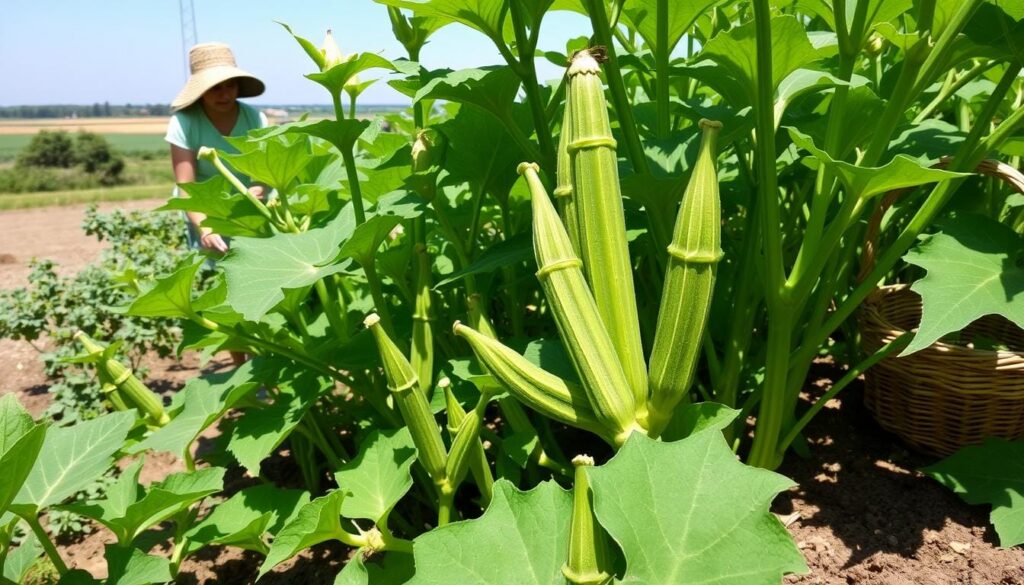
It’s key to keep picking okra to keep plants going strong. By using smart picking methods, farmers and gardeners can get more from their harvest.
Encouraging Further Pod Production
To keep okra plants at their best, follow these tips:
- Harvest pods every 1-2 days to keep them coming
- Pick pods when they’re 2-4 inches long
- Use clean, sharp tools to avoid hurting the plant
- Take off big pods to help new ones grow
Maintaining Plant Health
Healthy plants are the key to a great okra crop. Here’s what we suggest:
- Water plants regularly at the base
- Fertilize with balanced food every 3-4 weeks
- Mulch to keep soil moist
- Watch for pests
| Harvesting Parameter | Optimal Range |
|---|---|
| Harvest Frequency | Every 1-2 days |
| Ideal Pod Length | 2-4 inches |
| Days to First Harvest | 60-70 days after planting |
“Consistent care and timely harvesting are the secrets to a thriving okra garden.” – Agricultural Expert
Pro tip: Regular harvesting boosts your yield and keeps plants energized. They’ll keep producing pods all season.
Harvesting Different Types of Okra Varieties
Okra comes in many varieties, each with its own special traits. Knowing these differences helps gardeners and farmers get the best harvest and taste.
In the United States, some okra varieties stand out. They have unique features:
- Clemson Spineless: A favorite that stays tender at 4-5 inches, great for quick picking
- Burmese Okra: Has very long pods, 9-12 inches, and stays tender
- Sherwood Red Okra: Best for frying, tender up to 9 inches
- Gold Coast Okra: Tolerates drought, grows 6-7 feet tall
Growth and Harvest Characteristics
Each okra variety has its own harvesting challenges. Watching closely helps find the best time to pick.
Regional Performance Insights
Some varieties do better in certain climates. For example, Puerto Rico Everblush Okra grows well at about 6 inches and supports eco-friendly seed projects.
“Knowing your okra variety is key to successful harvesting and enjoying peak flavor and texture.”
When picking okra pods, consider their length, tenderness, and mucilage content. This ensures they meet your cooking needs.
Conclusion: Timing is Everything for Harvesting Okra
Learning when to harvest okra is key. It’s all about paying attention to the signs of when the pods are ready. By knowing these signs, gardeners can make their gardens very productive and rewarding.
Harvesting okra is more than just picking pods. It’s about taking care of the plants, checking the size of the pods, and making sure they keep growing. Check your plants every 2-3 days. Pick pods that are 2-4 inches long for the best taste. For more tips, visit expert gardening resources.
Recapping Key Harvesting Insights
Successful okra gardens need regular care. Give them about 1 inch of water a week, space them right, and watch the pods grow. These steps help you get a steady supply of fresh okra all season long.
Encouraging Optimal Harvesting Practices
Getting better at growing okra takes time. Each season is a chance to learn and get better. With patience and practice, you’ll know exactly when to pick those tasty okra pods.
